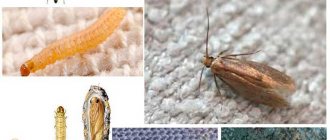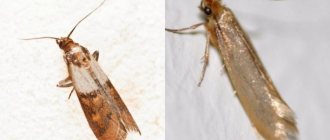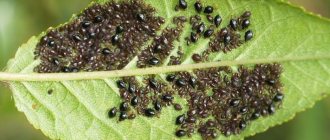Among the variety of beautiful bright butterflies, the appearance of the moth is very different in its modesty and homeliness. People have always struggled with the voracious insect. Today, mothballs have been replaced by modern chemical moth control agents. But before you endanger your household, you can try to get rid of moths with the help of plants. Herb against moths is an effective and safe remedy. But before hanging bunches of herbs around the house, you need to find out exactly which plant repels moths with its smell and how natural repellents work.
Traditional methods
The undoubted advantage of old grandmother's methods is that they are harmless to the health of people and pets. You can almost always find something in the household that repels the pest and prevents it from multiplying in the apartment. Even if the required ingredient is not available, purchasing it will not cause significant damage to the family budget.
Many people have heard about orange peels, laundry soap, all kinds of essential oils and vinegar. These and other means have been tested by time.
An interesting detail: the moth was able to adapt to the action of naphthalene and practically does not react to its smell. Folk (traditional) methods and means have not lost their effectiveness.
There are two types of moths living in our apartments. You need to select herbs based on where they will be used - in the kitchen or in the wardrobe.
All plants that have a pungent odor can be divided into two groups. Some can be adjacent to food, while others cannot.
Many herbs have both medicinal properties and the ability to repel insects. They can be safely used to combat moths that have settled in the kitchen. Plants cope with this task no worse than chemical industry products.
Ledum
This plant with soft white flowers can be found in forests and fields. It blooms almost the entire season. Ledum is often used in the fight against domestic insects, including moths. The main thing is not to overdo it - the strong aroma of this shrub can cause dizziness and nausea. To create bouquets, 2-3 branches are enough - moths will hear the smell, but for humans it will remain invisible.
Rose rosemary is an excellent moth repellent, however, you should be careful, as the plant is poisonous
Advice! Ledum is a poisonous plant, so you must be careful when collecting it yourself.
Tansy
This is the most famous folk remedy for all types of moths. Its specific smell forces the pest to leave its shelter. But since the plant is poisonous, it is not recommended to use it to get rid of food moths.
The flowers are especially toxic. In large quantities they are dangerous even for cattle. In small doses, tansy is used as a medicine for many diseases. Grass grows almost everywhere. Helps get rid of not only moths, but also other household pests.
Tansy reaches its greatest effectiveness during the flowering period. Plants must be dried before being placed in the closet. It is better to do this under a canopy in the fresh air.
For ease of use, flowers are made into unique bouquets. Collect 3-4 branches and tie them tightly into a broom. Hang in dressing rooms, closets and on mezzanines.
To prevent the grass from crumbling, it is placed in gauze bags. The packaging in which shoes are sold is perfect for this purpose, so there is no need to throw it away.
It is not recommended to place too many tansy in one closet. Its smell can provoke a negative reaction from the human respiratory system. Moths, unlike humans, sense even a faint aroma and strive to leave this place as soon as possible.
Dry grass should be renewed periodically. If the moth has already bred and hatched many larvae, tansy is used as an additional remedy. Measures to get rid of the pest must be carried out comprehensively.
Efficiency
To understand whether tansy helps against moths, you should first remember that this plant is a repellent, not an insecticide. This herb, like any other repellent, is an effective preventative. With its active use, tansy protects the living space from the penetration of pests.
If there are already too many fluttering parasites and their larvae, then folk recipes alone will not get rid of them.
In this case, it is necessary to use chemical insecticides.
Artemisia grass
Moths do not like the bitter smell just like the aroma of tansy. If you smell the plant, you will feel a peculiar taste in your mouth. In large quantities, wormwood can cause reactions such as dizziness and severe headaches.
To successfully fight moths in an apartment, it is enough to place several sprigs of dried wormwood in the closet. They will not cause any harm to health, but will drive away insects.
Under the influence of the aroma of grass, butterflies lose orientation in space and cannot lay eggs. Wormwood is used as a preventative and control measure. It is better not to use it in the kitchen against food moths.
Wormwood essential oil has the greatest effect. It drives moths out of the closet. Its vapors kill bacteria that are harmful to health.
It is useful to keep pads soaked in wormwood oil in a drawer or bag with socks. This will protect them from moths and help eliminate the problem of unpleasant foot odor.
Rosemary
It is a well-known culinary herb with anti-moth properties. The principle of using rosemary is the same - its branches are laid out on shelves or filled with thin fabric bags. The plant is often grown in flowerpots, which is also very useful. If desired, you can take rosemary essential oil.
Advice! The scent of rosemary is not particularly persistent, so this product requires frequent updating.
Lavender
The subtle smell found in the aromas of many cosmetics and perfumes is very unpleasant to moths. This feature of the plant is used in the development and manufacture of industrial products. Buy lavender-based essential oil at the pharmacy, soak napkins in it and place it on the shelves with your laundry.
In a closet with outerwear, “lavender” scraps are tied in a knot on a crossbar or placed in the pockets of fur coats and sheepskin coats. The good thing about this method is that the clothes removed from the wardrobe do not emit a chemical aroma, but smell quite pleasant.
Applications of lavender flowers:
- Dry plants are laid out in the depths of the shelves (3-4 branches are enough for each).
- As the aroma wears off, the flowers change.
- The supply should be kept in a tightly closed container. It is better if it is glassware.
When sending warm blankets for summer storage, dry them in the sun and put them in bags with lavender sprigs. In sealed packaging, the aroma lasts much longer than on cabinet shelves, so dried flowers do not need to be changed.
Storage and care rules
- Before sending the item for storage, it must be washed and rinsed in a decoction of fragrant herbs. Before placing the furs in a special case, you can treat them with Antimol spray and put horse chestnut fruits in your pockets.
Preventive measures - Over time, essential oils evaporate and plants lose their insecticidal properties. It is necessary to promptly replace expired sachets or bags of herbs with fresh ones. To avoid stains on clothing due to contact with essential oil, cotton balls and fabric soaked in it can be wrapped in foil.
- If you periodically ventilate and dry outerwear made of wool and fur, the moth larvae will die. Even vigorous shaking of the products will get rid of voracious parasites.
- Freezing from moths cannot always preserve things, since some species are not afraid of low temperatures. But steam treatment not only gets rid of larvae, but also damages egg laying.
- Kitchen and wardrobe cabinets should be periodically washed from the inside with herbal decoctions, table vinegar solution or laundry soap. Thorough cleaning and ventilation of the premises will forever rid the house of silver moths.
Mint
This herb is versatile. It is used not only in the wardrobe, but also in the kitchen. The smell is pleasant, it has a beneficial effect on the human nervous system and calms. For moths, the scent of mint is a signal to leave the apartment.
If you have a summer cottage, you can grow mint there. In the pharmacy it is sold already in dried form, although recently picked plants work better.
Mint grows well in indoor pots. You just need to get hold of rhizomes for planting. You can not only forget about moths, but also drink aromatic tea with fresh leaves.
If the butterfly has already laid eggs, then mint alone is unlikely to help. To combat larvae, you need to add tansy or wormwood to the bouquet.
It is useless to fight against food moths by laying out grass on shelves. First you need to get rid of contaminated products, clean the cabinets and only then place mint sprigs next to the cereals.
Since the larvae left the house along with the garbage, the eggs were washed off with a rag, all that remains is to get rid of the butterflies. The mint flavor will cope with this very quickly. In just a few days you will not see a single moth flying around the kitchen.
Thyme
It is truly impossible not to notice this fragrant grass in fields or meadows! It has such a persistent smell that your hands will smell all day long after touching the shoots. At the same time, the aroma is not intrusive and pleasant.
Thyme has a very beneficial effect on humans - it has a tonic and invigorating effect, improves blood circulation and metabolism, and helps to quickly restore the body after illness. But it has a negative effect on moth butterflies. To quickly remove all insects, place bouquets of thyme in your apartment and closets.
Other herbs
All folk (natural) remedies for moths are based on the use of odors that this insect is afraid of.
Can be used:
- sweet clover;
- chestnuts (leaves and fruits);
- yarrow;
- sage.
Some housewives make bouquets of them.
For this:
- Take a tansy branch and put wormwood on it.
- Then sweet clover, and even lower - sage.
- The bouquet is tied with an elastic band and the excess is cut off.
- Already in this form, the broom can be hung in the closet. There it will dry.
Dense wreaths are woven from fresh flowers and grass that protects against moths and dried in this form.
Plectranthus (moth tree)
What flower repels moths? In addition to geranium, plectranthus, a small shrub brought to us from South America, also has such beneficial properties. In our country, the “molar tree” is valued for its ease of care and fresh aroma. The smell of plectranthus is reminiscent of mint, camphor, lemon balm or lemon. It perfectly purifies the air in the house and allows you to get rid of moths in the shortest possible time.
Newspapers
Moths cannot stand the smell of printing ink. Our grandmothers covered the shelves of cupboards and wardrobes with newspapers. To protect your favorite fur coat from damage, you can remember the old folk method and put several crumpled newspapers in a case with outerwear.
To achieve the greatest effect, the press must be fresh. When storing winter boots in your closet, stuff your boots and boots tightly with crumpled up newspaper. In this way, two problems are solved: the shoes retain their shape, and moths will never appear in them.
Fragrant tobacco
Moths are afraid of the smell of tobacco, so it can safely be called another effective home remedy. Do not confuse fragrant tobacco with smoking tobacco! The first is a houseplant, the second is a mixture for cigarettes and pipes. However, you can use both options! Pour the crushed tobacco into small textile bags and place them in cabinets. Don't forget to ventilate your wardrobe from time to time.
Place dried bunches of fragrant tobacco in the wardrobe where things are stored and moths will leave your home
Tobacco should not be placed in the pockets of clothing in order to protect it from moths. Things will become saturated with a specific aroma, which is very difficult to get rid of.
A few facts about moths
To date, insectologists have described several dozen varieties of this voracious small butterfly. Among the representatives of this family, in addition to the well-known clothes moth, there is a very large group of insects that prefer to eat food rather than wool, and their menu can be very diverse - from cereals and fruits to nightshade leaves, which are the favorite delicacy of the potato moth .
It would be naive to believe that moths, having no teeth or digestive system at all, can gnaw passages in the thickness of carpets, eat coat collars or make holes in the pages of tomes, as the book moth allegedly does. Of course, the small whitish butterfly itself is completely harmless, but it lays eggs, from which translucent tiny caterpillars hatch, with an insatiable appetite and superbly developed mouthparts. Here they are, these same worms, and tirelessly gnaw everything that comes their way.
Chasing moths fluttering around the house is a pointless activity. As a rule, almost all moths flying in apartments are males, so there is very little benefit from killing fluttering butterflies. Females are more careful - they travel around the home in “short dashes”, and in between flights they hide in the folds of curtains and clothes, where they lay eggs, from which harmful caterpillars then emerge.











